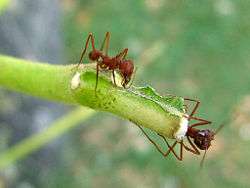Texas leafcutter ant
| Texas leafcutter ant | |
|---|---|
 | |
| Atta texana harvesting from a catalpa tree. | |
| Scientific classification | |
| Kingdom: | Animalia |
| Phylum: | Arthropoda |
| Class: | Insecta |
| Order: | Hymenoptera |
| Family: | Formicidae |
| Subfamily: | Myrmicinae |
| Tribe: | Attini |
| Genus: | Atta |
| Species: | A. texana |
| Binomial name | |
| Atta texana Buckley, 1860 | |
Atta texana is a fungus-farming ant species of the genus Atta, found in Texas, Louisiana and northeastern states of Mexico.[1] Common names include town ant, parasol ant, fungus ant, Texas leafcutter ant, cut ant, and night ant. It harvests leaves from over 200 plant species, and is considered a major pest of agricultural and ornamental plants,[2] as it can defoliate a citrus tree in less than 24 hours. Every colony has several queens and up to 2 million workers. Nests are built in well-drained sandy or loamy soil, and may reach a depth of 6 m (20 ft), have 1000 entrance holes, and occupy 420 m2 (4,500 sq ft).[1]
Description
A. texana workers measure 4 to 14 mm (0.16 to 0.55 in) in length, and are highly polymorphic. The back of the thorax has three pairs of spines. The ant has a narrow waist and is rusty brown in color.[1]
References
- 1 2 3 Robinson, William H. (2005). Handbook of Urban Insects and Arachnids. Cambridge University Press. pp. 238–239. ISBN 978-0-521-81253-5.
- ↑ "Texas Leaf Cutting Ant". Insects in the City. Texas AgriLife Extension. 2006-08-30. Archived from the original on October 15, 2008. Retrieved 2010-01-04.
- Evans, Arthur V (2007). "Ants, Bees, and Wasps: Order Hymenoptera". National Wildlife Federation Field Guide to Insects and Spiders & Related Species of North America. Sterling Publishing Co., Inc. p. 380. ISBN 978-1-4027-4153-1.
| Wikispecies has information related to Atta texana |
| Wikimedia Commons has media related to Atta texana. |